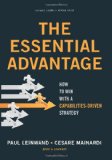Recommended Resources – An Interview with Paul Leinwand and Cesare Mainardi, authors of The Essential Advantage
The Essential Advantage: How to Win with a Capabilities-Driven Strategy
by Paul Leinwand and Cesare Mainardi
The conventional wisdom about strategy may be leading your company astray. In The Essential Advantage: How to Win with a Capabilities-Driven Strategy, Booz & Company’s Paul Leinwand and Cesare Mainardi maintain that success in any market accrues to firms with a coherence premium – a tight match between their strategic direction and the capabilities that make them unique.
Achieving coherence requires a sharpness of focus that few companies have mastered. This book helps you identify your firm’s distinctive blend of strategic direction and differentiated capabilities that give you the ‘right to win’ in your chosen markets.
Based on extensive research and providing a wealth of exercises, tools, and company examples from many industries – including Amazon.com, Walmart, Pfizer, Inditex (Zara), Itaú Unibanco, and Procter & Gamble – The Essential Advantage helps you construct a strategically coherent company in which the pieces reinforce each other instead of working at cross-purposes.
Additional Insights… An Interview with Paul Leinwand and Cesare Mainardi, authors of The Essential Advantage
SD: Why did you write The Essential Advantage?
PL and CM: Turbulent markets demand focus and discipline.
In this unpredictable economy, traditional approaches to strategy are a luxury most companies cannot afford. They cannot chart a future course based on a wide-eyed search for external growth: “There’s an attractive, adjacent market. Let’s go after it.” Rather, they need to conduct a clear-eyed assessment of what they as a firm already do exceptionally well, and then double down on those differentiating capabilities. Further, they need to limit their focus to, at most, six capabilities, and make those capabilities work together as a mutually reinforcing system that perpetuates competitive advantage.
SD: What is the ‘coherence premium?’
PL and CM: Coherent companies – those that possess a capabilities system that aligns their strategy with their product/service portfolio – generate superior performance over time, which is what we call the coherence premium.
For a company to be described as ‘coherent,’ according to our definition, it must be resolute and clear-minded in three critical ways: in the way the company creates value in the market (its chosen ‘way to play’); in the system of capabilities it deploys; and in the products and services it provides to its customers. The goal is balance: A coherent company strikes a balance where the right product and service portfolio naturally thrives within a capabilities system consciously chosen and implemented to support a deliberate strategy or way to play. We believe coherence confers a substantial premium, and we’ve measured it. We’ve established a strong correlation between coherence, as we define it, and superior performance over time in a number of industries.
SD: What does it mean to have a ‘right to win?’
PL and CM: The right to win is the confidence held by a company that its combination of way to play, system of capabilities, and products and services will outdeliver those of its competitors, drive sustained earnings growth, and thus give it an essential advantage in its market.
The right to win is the ability to enter or participate in any competitive market with the reasonably justified belief that you will succeed and create value. That belief stems from having chosen a differentiated way to play that is supported by a strong system of mutually reinforcing capabilities. A right to win isn’t a guarantee that things will go your way, but it reflects your relative coherence: the fact that you are better prepared to attract and keep customers than any of your competitors. A right to win can be measured in having share or margin advantage relative to competitors who compete within the same market.
SD: What is ‘capabilities-driven strategy?’
PL and CM: Capabilities-Driven Strategy (CDS) is a pragmatic series of choices designed to lead you to increasing levels of coherence and thus to gain an essential advantage for your company over time.
CDS starts with what you as a company do best – better than anyone else – and builds from that internal base of strength in making market participation choices. Traditionally, the practice of strategy has moved in the opposite direction. Companies scan the market for attractive expansion opportunities and build capabilities to suit those opportunities. We think they have it backward. It’s much harder to build capabilities than to leverage what you already do exceptionally well in capturing value. Those companies that focus on building a system of three to six best-in-class, interlocking capabilities that support their way to play achieve a right to win in their industries. They exploit their strengths over and over again, becoming even better at what they already excel at.
SD: What new ideas are you bringing to the table with capabilities-driven strategy?
PL and CM: Our take on capabilities and how they work in systems is new, as is our view of coherence as this three-part balanced system that confers a measurable premium.
While capabilities and competencies have been written about many times before, our firm’s perspective is that capabilities work together in systems and must be coherent with your way to play and the products and services you sell. Any one of these elements is not enough to gain the type of essential advantage that is sustainable over time. In addition, we believe that your starting point for strategy development is what you are already great at, rather than studying the industry and market for opportunities. This perspective is a shift from existing strategy perspectives as it affects nearly every major decision a company makes, from growth initiatives, portfolio strategy, and M&A opportunities to its approach to budgeting and cost cutting.
SD: Why now? Is it more important to consider capabilities when you develop a strategy now than it was, say, five years ago?
PL and CM: Economic downturns intensify the need for coherence and distinguish those who have achieved it.
CDS is not more important, but it’s certainly more timely, given the economic upheaval of the past couple of years. That creates an imperative for coherence. As a business, when you have a dramatic reduction in demand, you will be far less successful on the fringe. And you’re not going to be able to invest in those external market opportunities that traditional strategy would suggest. In a downturn, there is all the more reason to focus on what you already do well that your customers value and your competitors can’t beat. Finally, many industries are responding to the pressures of the last few years by differentiating themselves. The theoretical optimized industry is one with two or three players performing very different roles. Large downturns (such as this recession), technology disruptions, or regulatory shifts create discontinuities that simply accelerate the industry’s evolution toward this equilibrium state. The leading companies are getting out in front of this trend.
SD: It sounds logical to develop strategy by starting with one’s capabilities. What do most companies do instead?
PL and CM: Most companies look outside to adjacent markets for growth and invest in assets to exploit those opportunities.
The well-worn path to strategy in most industries is to seek growth outside your doors. You look at adjacent markets. You assess the attractiveness of the demand, the size and growth of the market, and the amount of profit that could be delivered, and you make participation choices and invest behind them. And, invariably, you invest in assets. You buy a company, invest in a brand, do R&D to meet that unmet need, expand into a new geography. These choices historically conferred advantage – first-mover, scale – but asset-based scale advantages have diminished in recent years, thanks to technology, cheap information, and outsourcing. Assets are important, but they are, increasingly, table stakes in most competitive industries; everyone in the game has them. Moreover, fixed assets are more difficult to leverage across diverse businesses than capabilities, and they tend to expire, become obsolete, or give way to related services. As the intrinsic value of assets diminishes, the competitive value of capabilities will only grow. In fact, we would assert that capabilities have already passed assets to become the primary means of creating value in most industries. They deserve at least equal weight in strategy setting.
SD: How does capabilities-driven strategy create value?
PL and CM: Capabilities-driven strategy creates value through four levers: effectiveness, focused investment, efficiency, and alignment.
First is an effectiveness benefit, which is realized simply in doing what you’re exceptionally good at over and over, day in and day out. Those companies that ‘sweat’ their capabilities continuously improve them and sustainably capture the top-line growth in their industries and, ultimately, market leadership. A coherent, focused, and aligned capabilities system creates not only value but a lock on value, as it is enormously difficult for competitors to replicate. Second, a coherent system focuses strategic investment on what matters. Coherent companies direct capital, time, and other resources with purpose to those activities, products, and businesses that will extend their lead. Third, there is the simple efficiency argument. Organizations that are clear-minded about where and how they participate in a market spend less on those capabilities that are not competitively differentiating. Finally, CDS forces alignment between strategic intent and day-to-day decision making. In a messy, incoherent world, those companies that can look through a capabilities lens set a straighter and more sustainable course and avoid costly missteps. These organizations move in lockstep, because everyone understands what’s important. They execute faster and with more force. And they attract, in turn, people who excel at the capabilities they wield with such mastery.
SD: Can you measure the success of a capabilities-driven strategy?
PL and CM: We have established a strong correlation between capabilities coherence and superior returns over time.
In fact, we have devised a way to measure the success of a capabilities-driven strategy and applied it to a number of industries. We call this measure the ‘coherence premium.’ To demonstrate it, we’ve examined a number of industries and mapped the level of capabilities coherence in the portfolio of each of the major players against their operating margins over the past five years. We have confirmed that coherence in capabilities correlates strongly with greater profitability (as measured by EBIT margin over a five-year period). Our approach to scoring coherence is similar across industries and can be distilled into three essential steps. First, we define the segments each company serves. Next, we identify the capabilities that drive value for the company in each segment. Finally, we determine the number of common capabilities across all the segments a company serves. The resulting score is then mapped against EBIT margin to determine the coherence premium. Our research shows that companies that invest mindfully in a capabilities system that supports their way to play and their product and service portfolio outperform the competition in their industry.
SD: Why haven’t more companies adopted capabilities-driven strategy as ‘the’ way to develop strategy?
PL and CM: It’s easier to accommodate incoherence than to fight for coherence.
Companies today operate in a business environment that encourages incoherence. Efforts to improve customer insight, for example, seem laudatory – but they can lead a business unit leader to propose bringing out a product line extension (‘Consumers are asking for it’) without considering how it fits with the company’s capabilities system. Or a benchmarking exercise might lead a functional leader to argue for new investment in distribution networks (‘Our competitors have them’ or ‘We must be great at this’) without recognizing that your existing distribution network, while it may not be the best, is more than adequate for your way to play, and the investment is better made elsewhere. It’s easier, or certainly less risky, to focus on incremental improvement in specific areas than sweeping change across the board.
What many people don’t realize is that CDS can be implemented at any level—function, business unit, subsidiary, enterprise. The complete coherence we’ve described is an ultimate destination, but there is also value created in the journey, in staking and exploiting ‘pockets’ of coherence. In an incoherent world, the relatively coherent company can prosper. In an incoherent company, the relatively coherent division can grow.
SD: Can you name some companies that have earned the coherence premium?
PL and CM: Walmart and Pfizer’s former consumer healthcare division are a couple of great case studies in capabilities coherence.
Walmart wrings maximum efficiency from its supply chain by integrating four capabilities – aggressive vendor management, expert point-of-sale data analytics, superior logistics, and rigorous working-capital management – that together deliver ‘everyday low prices’ to consumers. It’s a ‘sharp pencil’ capabilities system rooted in superior information. Because of its world-class point-of-sale analytics, Walmart can rigorously tailor its assortment to local consumption trends and go to vendors with better information than the vendors themselves have. This, in turn, increases the company’s leverage with suppliers and allows it to be extraordinarily efficient in moving inventory and managing working capital.
Pfizer’s consumer healthcare (PCH) division offers a great start-to-finish case study of capabilities-driven strategy development and the returns it affords. After absorbing the much larger consumer healthcare divisions of Warner-Lambert and Pharmacia in the early 2000s, PCH was looking to develop a focused growth strategy. Based on the breakthrough insight that consumer healthcare was more a healthcare business than a consumer products business, PCH restructured its entire business and product portfolio around six healthcare-oriented capabilities: pharma-like innovation, regulatory management, new product development, claims-based marketing, channel management, and the ‘Rx-to-OTC switch’ (adapting prescription pharmaceuticals into over-the-counter products). It divested a number of personal care and confectionary lines (e.g., Schick razors and Trident) and acquired other products (e.g., Purell) consistent with its chosen way to play. In 2006, Pfizer directly redeemed the value built by PCH by selling the business to Johnson & Johnson for an unprecedented US$16.6 billion, or 20.6 times EBITDA (compared to average multiples of 15 at the time).
SD: How can capabilities-driven strategy be applied to cutting costs?
PL and CM: CDS and cost reduction go hand in hand, as you need to make explicit choices about what to cut and what to keep.
In the course of developing and implementing a capabilities-driven strategy, companies make definitive choices about what matters and what doesn’t. They spend less on those capabilities that are not competitively differentiating. They don’t invest in making accounts payable world-class. They don’t fund R&D projects that won’t enhance their way to play. And they don’t overspend on marketing campaigns that won’t move the needle on sales.
Strangely, cost reduction exercises in most companies – no matter how extensive – are almost always divorced from business strategy, which makes little sense. You’re never just cutting costs. You’re making a decision that something is no longer strategically relevant, and that other things are essential. In coherent companies, every discretionary expenditure enhances a company’s capabilities system and thus strengthens its competitiveness.
SD: Does capabilities-driven strategy apply equally well to all industries and in all regions of the world?
PL and CM: We can’t imagine an industry or geography in which being good at what you do is not relevant or desirable.
The short answer is yes, CDS applies to all industries and all regions. Each company will come up with its own way to play based on its unique capabilities system – and in many cases, still, its advantaged assets. It’s true that different sectors and markets are at different stages of development and maturity. For example, in China, markets are still highly regulated, and domestic players protected. But even in such an environment, capabilities are essential – for example, working with the government to ensure distribution, or negotiating labor contracts to secure continued access to talent. Capabilities-driven strategy works in all contexts.
About the Authors
 Paul Leinwand is a Booz & Company partner based in Chicago. He works in the consumer, media, and digital practice and focuses on capabilities-driven strategy for consumer products companies. Paul Leinwand is a Booz & Company partner based in Chicago. He works in the consumer, media, and digital practice and focuses on capabilities-driven strategy for consumer products companies. |
 Cesare Mainardi is managing director of Booz & Company’s North American business and a member of the firm’s executive committee. He works with global Fortune 500 companies to help them achieve major business transformations. Cesare Mainardi is managing director of Booz & Company’s North American business and a member of the firm’s executive committee. He works with global Fortune 500 companies to help them achieve major business transformations. |
To learn more about Capabilities-Driven Strategy, click here.











Leave a Reply
Want to join the discussion?Feel free to contribute!